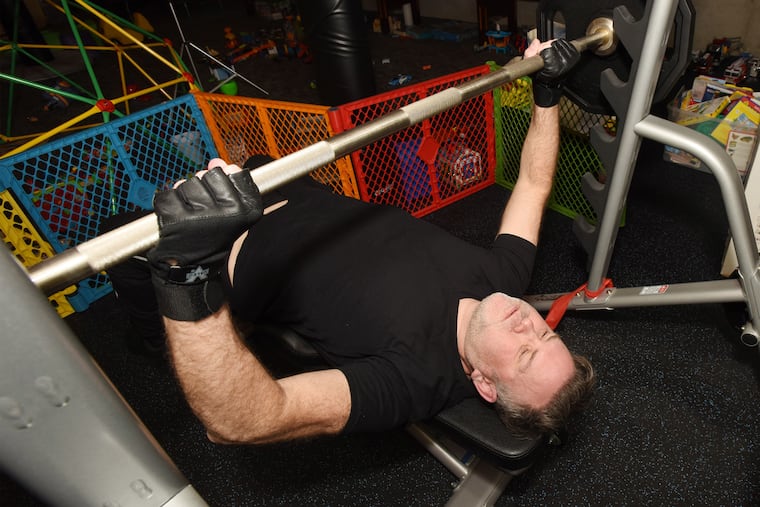Home gyms and workout injuries rose during the pandemic. Here’s how to set up a safe workout space
Follow this guide for a safe and effective home gym.

Herniated disks, muscle strain, face lacerations, and scratched corneas — Philadelphia-area doctors have seen their share of exercise-related injuries. Those injuries rose during the pandemic, as more people made do with at-home gym equipment when their local fitness center shut down.
Nationally, about 37,000 people injured themselves while exercising in 2020, up 49% from the year before, according to a report by MedicareAdvantage.com, which analyzed data from the U.S. Consumer Product Safety Commission’s National Electronic Injury Surveillance System (NEISS).
The most important tip doctors offer is simple:
“Know your limits,” said Stephen Stache Jr., chief of nonoperative sports medicine at Rothman Orthopaedic Institute.
» READ MORE: Home gyms are here to stay, from a corner in a spare room to a club-grade spa
Need more help? Here’s how to work out at home without hurting yourself (or anyone else).
Set up your gym for success
Choose equipment that fits your space. Allow 2 to 3 feet surrounding each piece of equipment and enough ceiling height to accommodate the workout, said Rick Clendaniel, general manager of Fitness Exchange, which has three Philadelphia locations. For example, an elliptical machine requires a 7-foot ceiling. If you’re hunched over, you can put strain on your back or fall off.
Research safety ratings. With treadmills, for example, the frame on cheaper models may be bolted rather than welded. With use over time, the frame can snap. Proper maintenance can help prevent accidents.
Control the temperature. You could strain muscles if your space is too cold or get dehydrated in a room that’s too hot, Stache said.
Have a phone nearby to call for help, especially if you plan to work out alone.
Exercise the right way
Learn proper technique before starting any new exercise. Ankle sprains, muscle strains, and twisted knees are common injuries from using exercise equipment incorrectly. Jeremy Simon, chief of physical medicine and rehabilitation at Rothman Orthopaedic Institute, once treated a patient who had been lifting weights while looking up at a workout video on a screen — improper form that resulted in a herniated disk in their neck.
Warm up and cool down. Always take a few minutes to stretch and release tension.
Wear proper footwear. You shouldn’t be able to easily bend your shoes in half, especially for heavy-impact exercise, Simon said. Supportive shoes will also help prevent overpronation, which is when your feet turn inward during an exercise, straining muscles, tendons, and ligaments.
Practice safety with exercise equipment
Don’t overdo it with the weights. Lifting weights that are too heavy requires a jerking motion, which can cause stress fractures and disk herniation. It can happen even to exercise buffs, like Brett Rubinson. Though he’d been lifting for 35 years, about five years ago, he partially tore the pectoral muscle in his chest while lifting too much weight with a personal trainer.
“The trainer was assessing my strength, but had me lift too much weight in an exercise I hadn’t done before,” recalled Rubinson, 57.
Store equipment safely. If there are children in the house, be sure free weights are stored away when not in use. Anchor benches and racks to the floor or wall so they can’t tip over.
Tread carefully with treadmills. Treadmills caused the most injuries in 2020 — nearly a quarter of all at-home exercise injuries, according to NEISS. In 2019, of the 22,500 treadmill-related injuries treated at U.S. emergency departments, about 2,000 were in children under 8 years old, the U.S. Consumer Product Safety Commission estimates.
Some treadmills have built-in child-safety measures, such as requiring a code or key to start. If yours has a key, make sure you remove it at the end of your workout, so children can’t accidentally turn on the treadmill. Keep folding treadmills folded and latched when not in use.
Watch out for resistance bands. Accidents happen when bands snap back too quickly or break. Choose a stable place to attach a band, like a wall-attached pull-up bar, rather than under a piece of furniture or on a door handle.
Resistance bands cause many of the exercise-related injuries treated at Wills Eye Hospital, such as traumatic iritis, corneal abrasions, subconjunctival hemorrhage, periocular bruising, and lacerations, said Christine Chung, director of the Wills Eye emergency department and director of the consult service at Thomas Jefferson University Hospital.
Choose age-appropriate exercise
Teenagers: Fitness is a great habit to instill in adolescents and teenagers, but their bodies can’t handle the same kind of workout as adults. Too much weight and improper form can be especially dangerous for preteens and teenagers whose spines aren’t finished growing and are particularly prone to injury, said Simon.
Adults: Know your body, said Stache. Some people prefer working out in the morning on an empty stomach, and they can do that safely. That might lead to light-headedness and an increased fall risk for others.
To prevent cramping, drink plenty of water or a drink with electrolytes before, during, and after a workout. And don’t overdo it. Working out when you’re tired leads to injury.
Older adults: The NEISS statistics found that people over 65 suffered more than a quarter of at-home exercise injuries because of diminished flexibility, loss of muscle mass, and worsening balance, among other factors.
“Naturally over time, people lose disk height between vertebrae, which leads to arthritis in the joints of the back, stiffening of the joints, and thickening of some of the ligaments,” said Simon.
He recommends core strengthening and flexibility exercises to help prevent injuries.